| View previous topic :: View next topic |
| Author |
Message |
Jesito


Joined: 24 Aug 2007
Posts: 5745
Location: Olivella, Catalonia, (Spain)
Expire: 2015-01-07
|
 Posted: Mon Sep 11, 2017 9:30 am Post subject: Building an adaptor for the Pentacon 80mm projection lens Posted: Mon Sep 11, 2017 9:30 am Post subject: Building an adaptor for the Pentacon 80mm projection lens |
 |
|
Jesito wrote:
The Pentacon 80 lens is a projection lens for 35mm slide projectors. It is the successor of the Diaplan 80mm f/2.8 (that was made of metal), the Pentacon’s body is all plastic. It does not have any iris to control de light. Its body has a groove along it to allow focusing when placed in a projector. It does not have any coating to protect against flare because the light is supposed to come opposite to what it comes in any camera lens. Not very fancy to be used on a camera for such limitations.
But it has some powers:
- It's a Cooke triplet design (three elements of single lenses) that could provide a special bubble bokeh and a vintage look to the pictures, similar to the Trioplan 100mm but with smaller bubbles.
 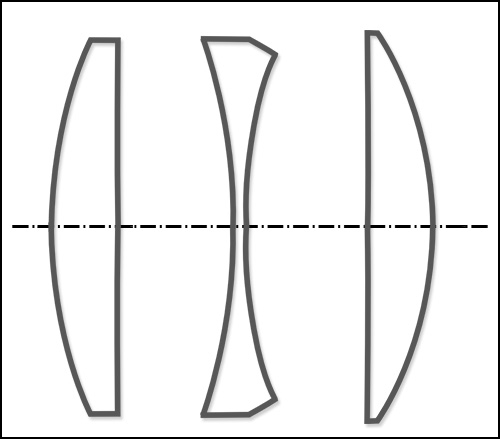
- Very lightweight (75g) that allows for a simple plastic adapter to use it.
- Good resolution (common on the projection lenses).
- Covering the full frame 35mm sensor.
So I decided to build my own adapter using my 3D printers. The target was to have the widest focusing range possible (from macro to infinity if possible) and a standard mount that could be used in most of the current digital cameras (mirror or mirrorless). Since I had several adapters to the L39 screw I decided to use it as the lens mount. So the barrel had to have a L39 screw on the base and a cylinder that would hold the lens, with some kind of guide for the helicoid groove. It took me several iterations until I reached something usable.
This is the barrel being printed on my M Prime One printer, the screw is printed on the top to ensure accuracy. I used black PLA and layers of 0.1mm (higher layers do not provided enough resolution for the L39 mount screw). As you can see in the back of the barrel, there is a hole to place the screw that will fix the lens in position.
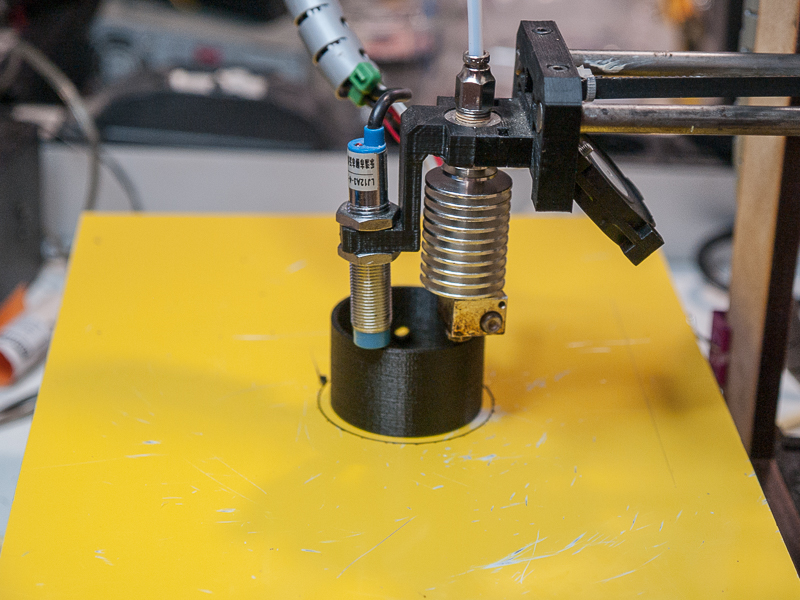
And this is the barrel once printed:
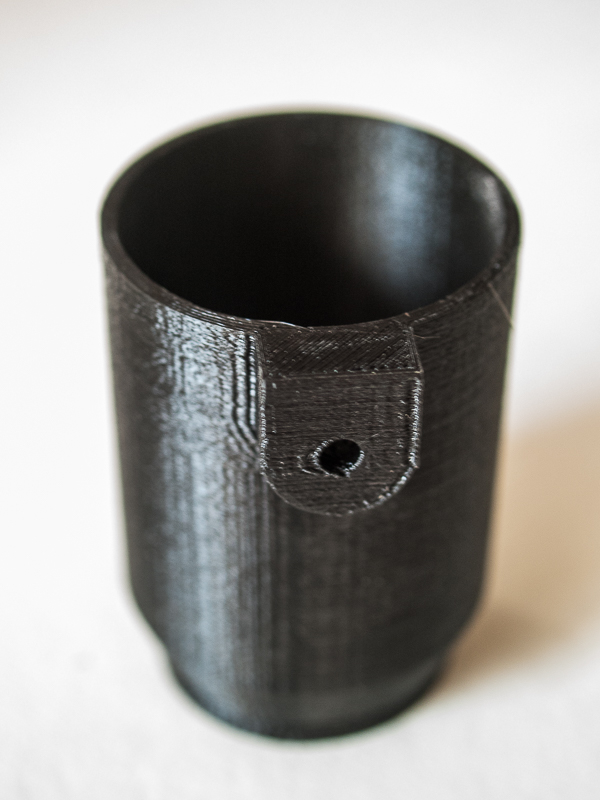
To guide the lens along the barrel I used a M4 screw with Allen head, and a M4 nut. The screw fits well inside the groove of the lens. I also printed a knob that fits tight on the head of the allen screw, it has to be glued in place. I used some Superglue gel.
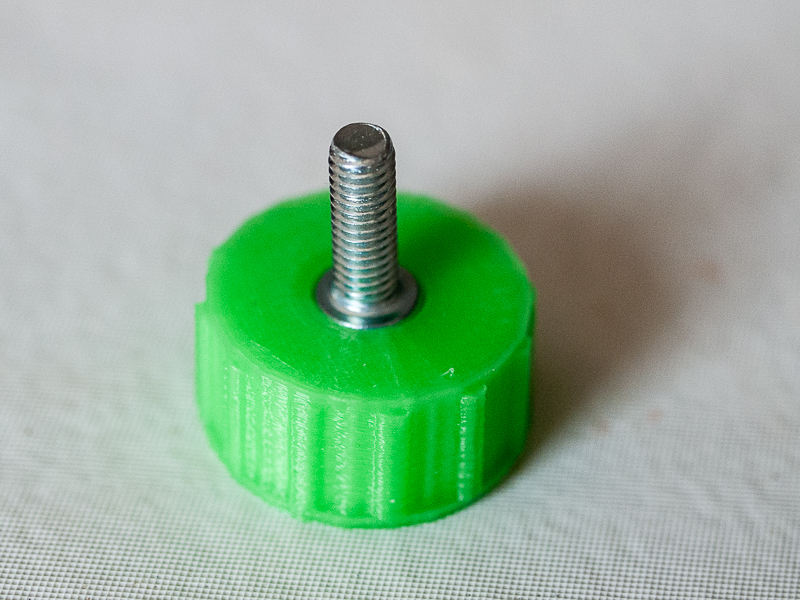 � �
The nut is placed inside the barrel. To ensure tightness, i did cast the place for the nut a bit narrower than needed and then forced the nut inside with the help of the heath from the tip of a soldering iron. (No Superglue inside the lenses, the vapours can damage the optics)
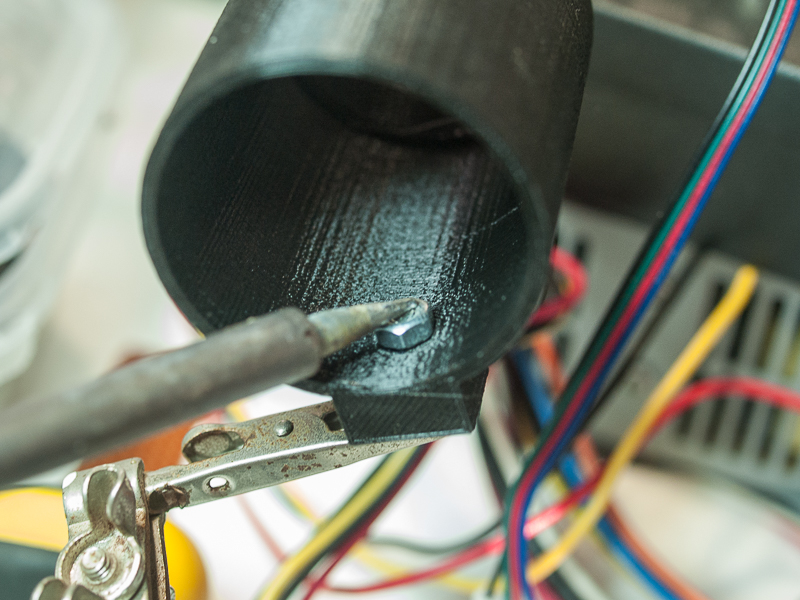
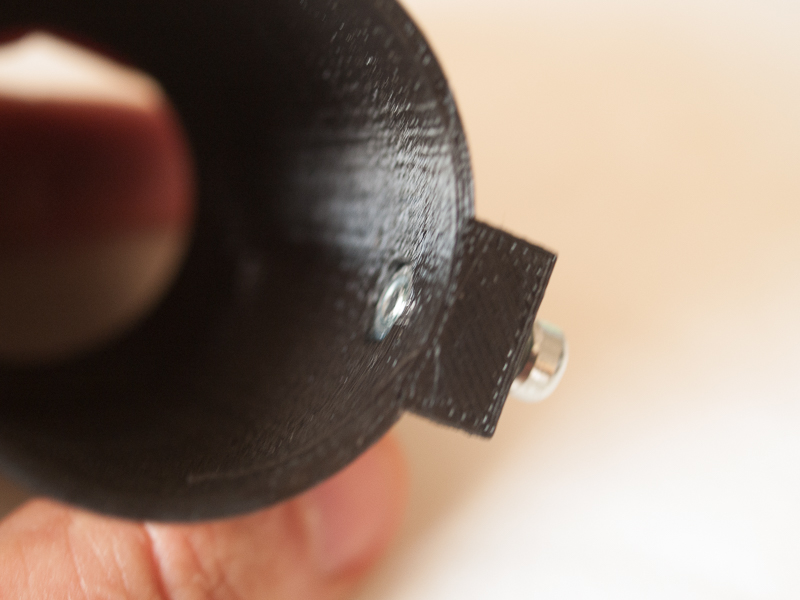
Â
This ensure that once cooled, the nut will remain in place.
Since the lens has no coating at all, a shade would be needed, so I printed one that fits on the front just by pressure. It took me several iterations to find the right diameter size to allow fitting and keeping well in place. It's a matter of tenths of millimeter
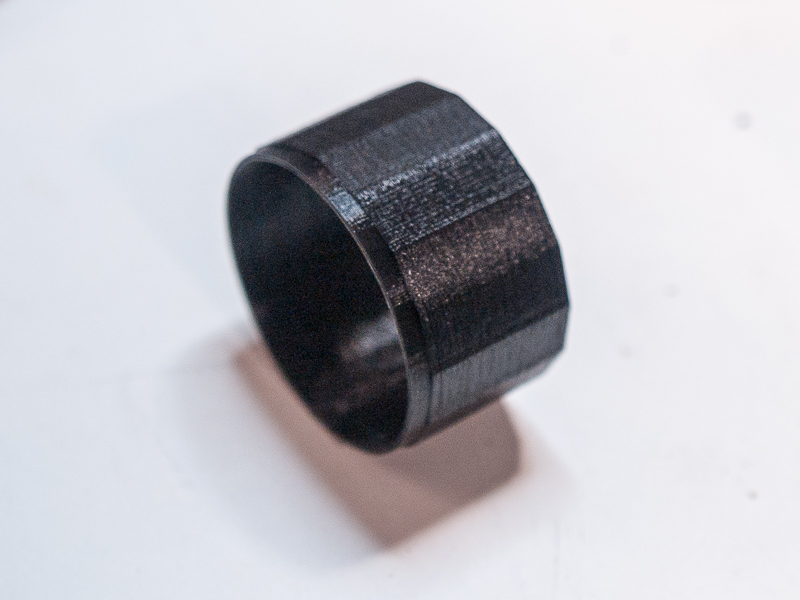
Then putting all togheter: Make the screw protruding a bit inside the barrel and align the groove with it, screw in a little (being extremely careful of not using excessive pressure to avoid damaging the lens) and finally placing the shade in place:
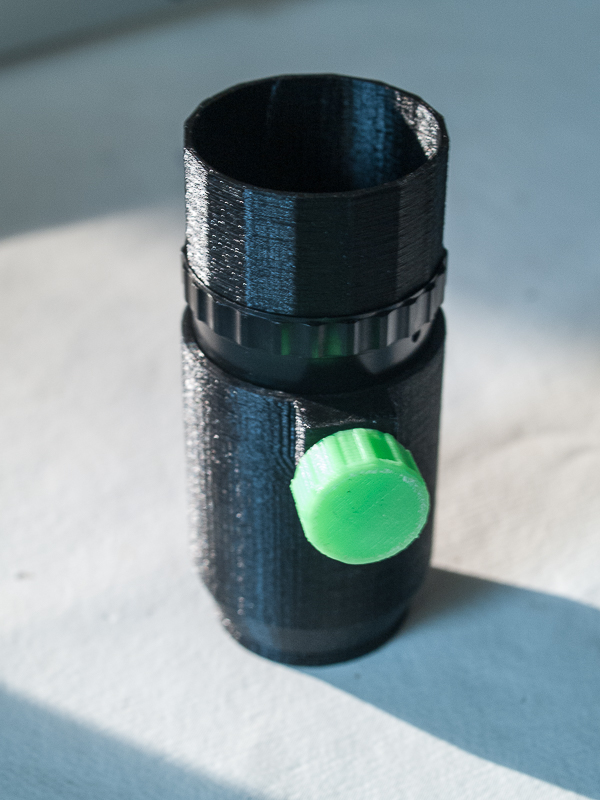
Once this done, just screwing in the L39 adapter gives an usable lens. Tested on a NEX-F3, a Samsung NX210 that sport APS-C sensors. Next steps will be trying on u4/3 and FF.
At this time I can focus macro (don’t know yet the macro relationship) but it cannot reach full infinity, but quite close. (around 100m far). A difficulty is the narrow DOF. An 80mm lens with 2.8 aperture gives no much DOF).
Next steps (beside the testing on other cameras) will be trying to modify the adapter to hold some kind of removable fixed iris (a circle with a hole inside) to reduce a bit the DOF, because the results are very promising.
Selfie on the NEX-F3
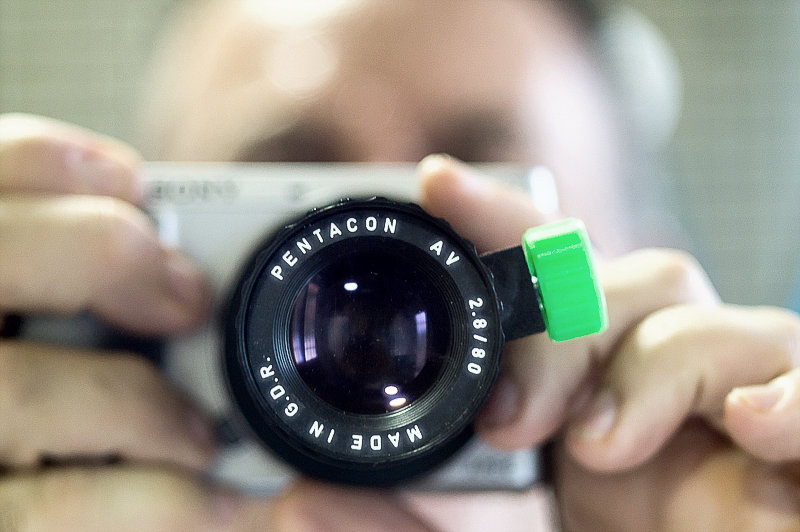
The lens on a NX210 Samsung camera:

And some samples:
Missed focus but good for showing wich bokeh can be attained.
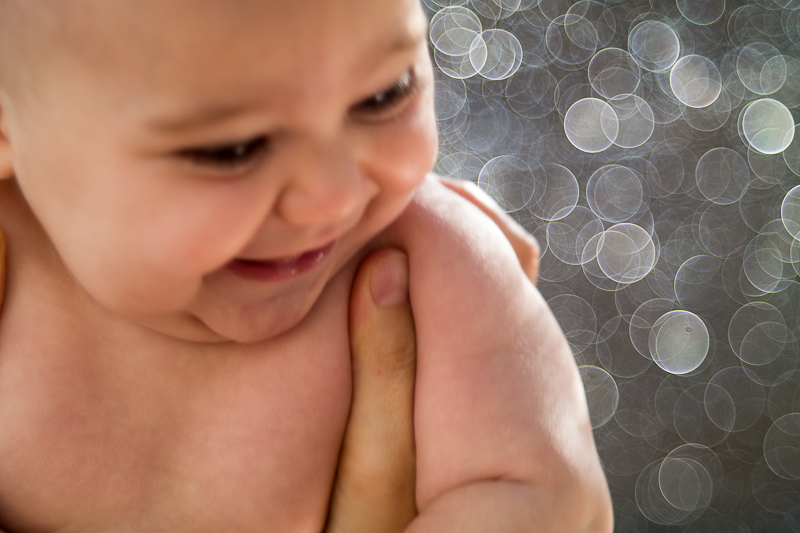
Close focusing:
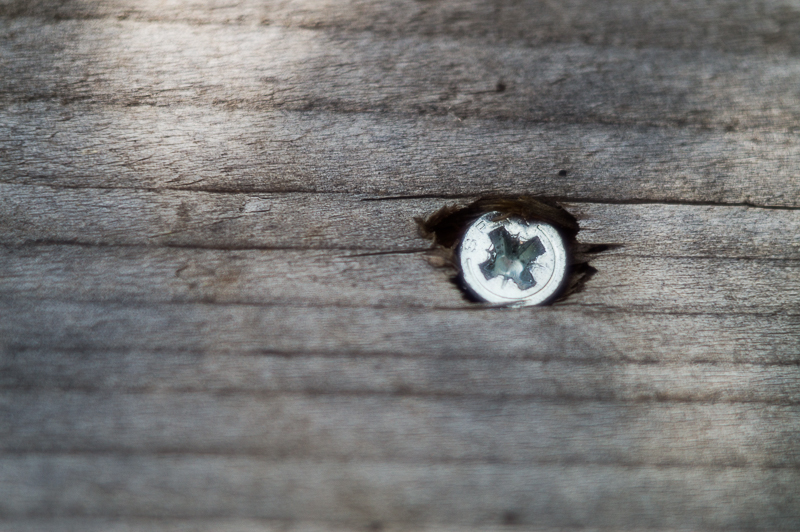
Farthest focusing:
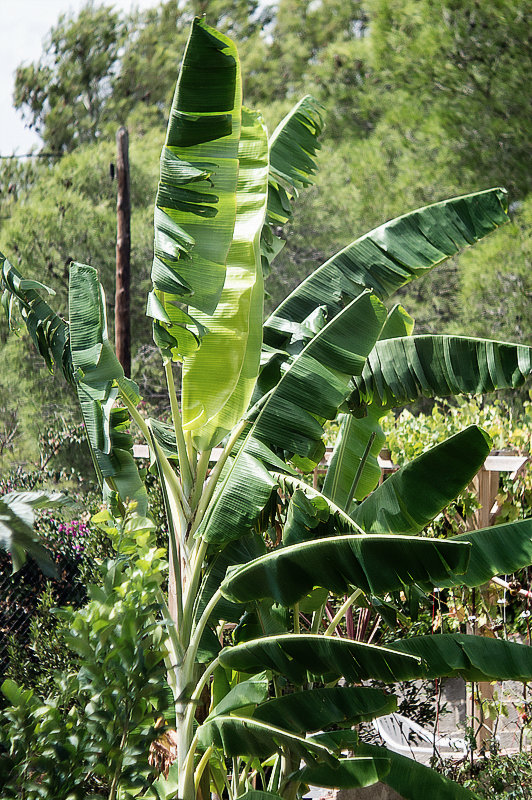
More testing to be done on u4/3 and FF cameras.
_________________
Jesito, Moderator 
Jesito's backsack:
Zooms Sigma 70-300, Tamron 35-135 and 70-210 short, 70-210 long, 28-70 CF Macro, 35-70, 35-80, Vivitar 70-210 KA, Tamron 70-250.
Fixed Industar-50, , Tamron 24mm, Tamron 135mm, Sands Hunter 135mm, Pancolar 50mm, Volna-3, many Exakta lenses
DSLR SIGMA SD9 & SD14, EOS 5D, Sony A700 and NEXF3, Oly E-330, E-400, E-450, E-1
TLR/6x6/645 YashicaMat, Petri 6x45, Nettar, Franka Solida, Brilliant
SLR Minolta X300, Fuji STX II, Praktica VLC3, Pentax P30t, EXA500, EXA 1A, Spotmatic(2), Chinon CM-4S, Ricoh, Contax, Konica TC-X , Minolta 5000, 7000i, 3Sxi, EOS 500 and CX
Rangefinders Chinon 35EE, Konica C35 auto, Canonet 28, Yashica Lynx, FED-2, Yashica electro 35, Argus C3 & C4, Regula Cita III, Voigtlander Vitoret (many), Welta Welti-I, Kodak Signette 35, Zorki-4, Bessa-R & L, Minolta Weathermatic, olympus XA2
Compact Film Konica C35V, Voigtlander Vitorets, Canon Prima Super 105, Olympus XA2 and XA3
Compact Digital Olympus C-5050, Aiptek Slim 3000, Canon Powershot A540, Nikon 5200, SIGMA DP1s, Polaroid X530, IXUS55, Kodak 6490, Powershot G9 and G10
CSCCanon EOS-M, Samsung NX100 and NX210, Lumix G5, NEX-F3
Last edited by Jesito on Sat Feb 29, 2020 4:03 pm; edited 3 times in total |
|
| Back to top |
|
 |
hoanpham

Joined: 31 Jan 2011
Posts: 2575
Expire: 2015-01-18
|
 Posted: Mon Sep 11, 2017 8:08 pm Post subject: Posted: Mon Sep 11, 2017 8:08 pm Post subject: |
 |
|
hoanpham wrote:
Advanced DIY 😳 |
|
| Back to top |
|
 |
IAZA


Joined: 16 Apr 2010
Posts: 2587
Location: Indonesia
|
 Posted: Tue Sep 12, 2017 1:02 am Post subject: Posted: Tue Sep 12, 2017 1:02 am Post subject: |
 |
|
IAZA wrote:
nice result.
the green part make it like toy though.
_________________
nex5, Olympus EPM1, yashica half 14, Canon eos 650 want to see samples of mine? please click My lenses
and My gallery
~Suat~ |
|
| Back to top |
|
 |
kds315*


Joined: 12 Mar 2008
Posts: 16664
Location: Weinheim, Germany
Expire: 2021-03-09
|
 Posted: Tue Sep 12, 2017 8:50 am Post subject: Posted: Tue Sep 12, 2017 8:50 am Post subject: |
 |
|
kds315* wrote:
Nicely done, certainly much lighter than my solution!
_________________
Klaus - Admin
"S'il vient a point, me souviendra" [Thomas Bohier (1460-1523)]
http://www.macrolenses.de for macro and special lens info
http://www.pbase.com/kds315/uv_photos for UV Images and lens/filter info
https://www.flickr.com/photos/kds315/albums my albums using various lenses
http://photographyoftheinvisibleworld.blogspot.com/ my UV BLOG
http://www.travelmeetsfood.com/blog Food + Travel BLOG
https://galeriafotografia.com Architecture + Drone photography
Currently most FAV lens(es):
X80QF f3.2/80mm
Hypergon f11/26mm
ELCAN UV f5.6/52mm
Zeiss UV-Planar f4/60mm
Zeiss UV-Planar f2/62mm
Lomo Уфар-12 f2.5/41mm
Lomo Зуфар-2 f4.0/350mm
Lomo ZIKAR-1A f1.2/100mm
Nikon UV Nikkor f4.5/105mm
Zeiss UV-Sonnar f4.3/105mm
CERCO UV-VIS-NIR f1.8/45mm
CERCO UV-VIS-NIR f4.1/94mm
CERCO UV-VIS-NIR f2.8/100mm
Steinheil Quarzobjektiv f1.8/50mm
Pentax Quartz Takumar f3.5/85mm
Carl Zeiss Jena UV-Objektiv f4/60mm
NYE OPTICAL Lyman-Alpha II f1.1/90mm
NYE OPTICAL Lyman-Alpha I f2.8/200mm
COASTAL OPTICS f4/60mm UV-VIS-IR Apo
COASTAL OPTICS f4.5/105mm UV-Micro-Apo
Pentax Ultra-Achromatic Takumar f4.5/85mm
Pentax Ultra-Achromatic Takumar f5.6/300mm
Rodenstock UV-Rodagon f5.6/60mm + 105mm + 150mm
|
|
| Back to top |
|
 |
Jesito


Joined: 24 Aug 2007
Posts: 5745
Location: Olivella, Catalonia, (Spain)
Expire: 2015-01-07
|
 Posted: Tue Sep 12, 2017 9:15 am Post subject: Posted: Tue Sep 12, 2017 9:15 am Post subject: |
 |
|
Jesito wrote:
| hoanpham wrote: |
| Advanced DIY |
Thanks for commenting, Hoan.
Not so advanced. Nowadays most of the teenagers have access to a 3D printer and do things far more complex... ;o)
_________________
Jesito, Moderator 
Jesito's backsack:
Zooms Sigma 70-300, Tamron 35-135 and 70-210 short, 70-210 long, 28-70 CF Macro, 35-70, 35-80, Vivitar 70-210 KA, Tamron 70-250.
Fixed Industar-50, , Tamron 24mm, Tamron 135mm, Sands Hunter 135mm, Pancolar 50mm, Volna-3, many Exakta lenses
DSLR SIGMA SD9 & SD14, EOS 5D, Sony A700 and NEXF3, Oly E-330, E-400, E-450, E-1
TLR/6x6/645 YashicaMat, Petri 6x45, Nettar, Franka Solida, Brilliant
SLR Minolta X300, Fuji STX II, Praktica VLC3, Pentax P30t, EXA500, EXA 1A, Spotmatic(2), Chinon CM-4S, Ricoh, Contax, Konica TC-X , Minolta 5000, 7000i, 3Sxi, EOS 500 and CX
Rangefinders Chinon 35EE, Konica C35 auto, Canonet 28, Yashica Lynx, FED-2, Yashica electro 35, Argus C3 & C4, Regula Cita III, Voigtlander Vitoret (many), Welta Welti-I, Kodak Signette 35, Zorki-4, Bessa-R & L, Minolta Weathermatic, olympus XA2
Compact Film Konica C35V, Voigtlander Vitorets, Canon Prima Super 105, Olympus XA2 and XA3
Compact Digital Olympus C-5050, Aiptek Slim 3000, Canon Powershot A540, Nikon 5200, SIGMA DP1s, Polaroid X530, IXUS55, Kodak 6490, Powershot G9 and G10
CSCCanon EOS-M, Samsung NX100 and NX210, Lumix G5, NEX-F3
Last edited by Jesito on Fri Sep 15, 2017 7:10 am; edited 1 time in total |
|
| Back to top |
|
 |
Jesito


Joined: 24 Aug 2007
Posts: 5745
Location: Olivella, Catalonia, (Spain)
Expire: 2015-01-07
|
 Posted: Tue Sep 12, 2017 9:17 am Post subject: Posted: Tue Sep 12, 2017 9:17 am Post subject: |
 |
|
Jesito wrote:
| IAZA wrote: |
nice result.
the green part make it like toy though. |
Yes, it does. It's the only colour I had available, and I thought all black would be too dark.
Anyway, it's not more than a toy ;o)
_________________
Jesito, Moderator 
Jesito's backsack:
Zooms Sigma 70-300, Tamron 35-135 and 70-210 short, 70-210 long, 28-70 CF Macro, 35-70, 35-80, Vivitar 70-210 KA, Tamron 70-250.
Fixed Industar-50, , Tamron 24mm, Tamron 135mm, Sands Hunter 135mm, Pancolar 50mm, Volna-3, many Exakta lenses
DSLR SIGMA SD9 & SD14, EOS 5D, Sony A700 and NEXF3, Oly E-330, E-400, E-450, E-1
TLR/6x6/645 YashicaMat, Petri 6x45, Nettar, Franka Solida, Brilliant
SLR Minolta X300, Fuji STX II, Praktica VLC3, Pentax P30t, EXA500, EXA 1A, Spotmatic(2), Chinon CM-4S, Ricoh, Contax, Konica TC-X , Minolta 5000, 7000i, 3Sxi, EOS 500 and CX
Rangefinders Chinon 35EE, Konica C35 auto, Canonet 28, Yashica Lynx, FED-2, Yashica electro 35, Argus C3 & C4, Regula Cita III, Voigtlander Vitoret (many), Welta Welti-I, Kodak Signette 35, Zorki-4, Bessa-R & L, Minolta Weathermatic, olympus XA2
Compact Film Konica C35V, Voigtlander Vitorets, Canon Prima Super 105, Olympus XA2 and XA3
Compact Digital Olympus C-5050, Aiptek Slim 3000, Canon Powershot A540, Nikon 5200, SIGMA DP1s, Polaroid X530, IXUS55, Kodak 6490, Powershot G9 and G10
CSCCanon EOS-M, Samsung NX100 and NX210, Lumix G5, NEX-F3 |
|
| Back to top |
|
 |
Jesito


Joined: 24 Aug 2007
Posts: 5745
Location: Olivella, Catalonia, (Spain)
Expire: 2015-01-07
|
 Posted: Tue Sep 12, 2017 9:37 am Post subject: Posted: Tue Sep 12, 2017 9:37 am Post subject: |
 |
|
Jesito wrote:
| kds315* wrote: |
| Nicely done, certainly much lighter than my solution! |
Thanks Klaus. Do you mean the one you published in your Blog around 2015? (the one with a M65 and a M42 helicoid?).
That one is much sturdy and configurable... It was a source of inspiration for my adapter for the enlarger lenses, (Pentax-k helicoid instead).
I like the 3D printing process because it's really quick from the idea to the prototype, many times usable prototypes.
But if one wants somethig really strong and durable, nothing like your solution.
_________________
Jesito, Moderator 
Jesito's backsack:
Zooms Sigma 70-300, Tamron 35-135 and 70-210 short, 70-210 long, 28-70 CF Macro, 35-70, 35-80, Vivitar 70-210 KA, Tamron 70-250.
Fixed Industar-50, , Tamron 24mm, Tamron 135mm, Sands Hunter 135mm, Pancolar 50mm, Volna-3, many Exakta lenses
DSLR SIGMA SD9 & SD14, EOS 5D, Sony A700 and NEXF3, Oly E-330, E-400, E-450, E-1
TLR/6x6/645 YashicaMat, Petri 6x45, Nettar, Franka Solida, Brilliant
SLR Minolta X300, Fuji STX II, Praktica VLC3, Pentax P30t, EXA500, EXA 1A, Spotmatic(2), Chinon CM-4S, Ricoh, Contax, Konica TC-X , Minolta 5000, 7000i, 3Sxi, EOS 500 and CX
Rangefinders Chinon 35EE, Konica C35 auto, Canonet 28, Yashica Lynx, FED-2, Yashica electro 35, Argus C3 & C4, Regula Cita III, Voigtlander Vitoret (many), Welta Welti-I, Kodak Signette 35, Zorki-4, Bessa-R & L, Minolta Weathermatic, olympus XA2
Compact Film Konica C35V, Voigtlander Vitorets, Canon Prima Super 105, Olympus XA2 and XA3
Compact Digital Olympus C-5050, Aiptek Slim 3000, Canon Powershot A540, Nikon 5200, SIGMA DP1s, Polaroid X530, IXUS55, Kodak 6490, Powershot G9 and G10
CSCCanon EOS-M, Samsung NX100 and NX210, Lumix G5, NEX-F3 |
|
| Back to top |
|
 |
Jesito


Joined: 24 Aug 2007
Posts: 5745
Location: Olivella, Catalonia, (Spain)
Expire: 2015-01-07
|
 Posted: Fri Sep 15, 2017 7:03 am Post subject: Posted: Fri Sep 15, 2017 7:03 am Post subject: |
 |
|
Jesito wrote:
A couple of shots with the lens mounted on the EOS-M:
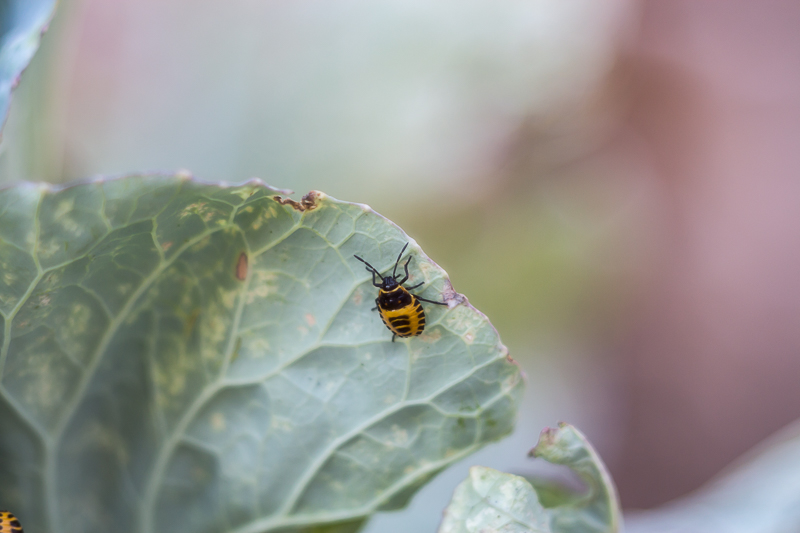
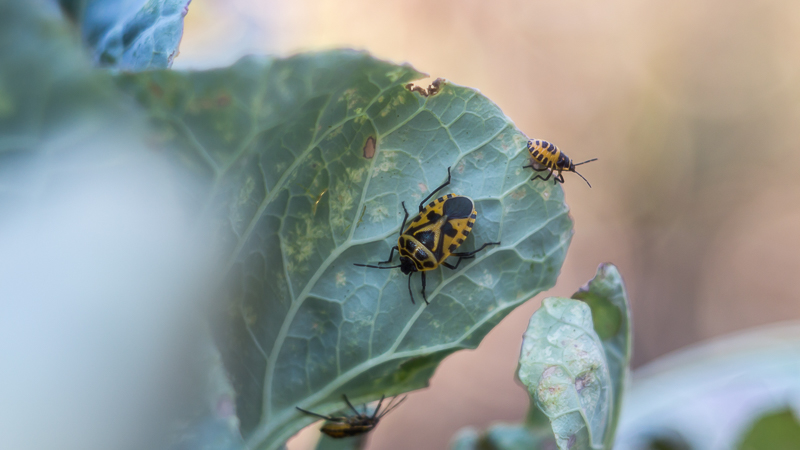
_________________
Jesito, Moderator 
Jesito's backsack:
Zooms Sigma 70-300, Tamron 35-135 and 70-210 short, 70-210 long, 28-70 CF Macro, 35-70, 35-80, Vivitar 70-210 KA, Tamron 70-250.
Fixed Industar-50, , Tamron 24mm, Tamron 135mm, Sands Hunter 135mm, Pancolar 50mm, Volna-3, many Exakta lenses
DSLR SIGMA SD9 & SD14, EOS 5D, Sony A700 and NEXF3, Oly E-330, E-400, E-450, E-1
TLR/6x6/645 YashicaMat, Petri 6x45, Nettar, Franka Solida, Brilliant
SLR Minolta X300, Fuji STX II, Praktica VLC3, Pentax P30t, EXA500, EXA 1A, Spotmatic(2), Chinon CM-4S, Ricoh, Contax, Konica TC-X , Minolta 5000, 7000i, 3Sxi, EOS 500 and CX
Rangefinders Chinon 35EE, Konica C35 auto, Canonet 28, Yashica Lynx, FED-2, Yashica electro 35, Argus C3 & C4, Regula Cita III, Voigtlander Vitoret (many), Welta Welti-I, Kodak Signette 35, Zorki-4, Bessa-R & L, Minolta Weathermatic, olympus XA2
Compact Film Konica C35V, Voigtlander Vitorets, Canon Prima Super 105, Olympus XA2 and XA3
Compact Digital Olympus C-5050, Aiptek Slim 3000, Canon Powershot A540, Nikon 5200, SIGMA DP1s, Polaroid X530, IXUS55, Kodak 6490, Powershot G9 and G10
CSCCanon EOS-M, Samsung NX100 and NX210, Lumix G5, NEX-F3
Last edited by Jesito on Sat Feb 29, 2020 4:04 pm; edited 1 time in total |
|
| Back to top |
|
 |
kds315*


Joined: 12 Mar 2008
Posts: 16664
Location: Weinheim, Germany
Expire: 2021-03-09
|
 Posted: Fri Sep 15, 2017 9:08 am Post subject: Posted: Fri Sep 15, 2017 9:08 am Post subject: |
 |
|
kds315* wrote:
Jesito, is the lens clear inside? It lacks a bit contrast (and also sharpness) if I may say.
At least I expected that.
_________________
Klaus - Admin
"S'il vient a point, me souviendra" [Thomas Bohier (1460-1523)]
http://www.macrolenses.de for macro and special lens info
http://www.pbase.com/kds315/uv_photos for UV Images and lens/filter info
https://www.flickr.com/photos/kds315/albums my albums using various lenses
http://photographyoftheinvisibleworld.blogspot.com/ my UV BLOG
http://www.travelmeetsfood.com/blog Food + Travel BLOG
https://galeriafotografia.com Architecture + Drone photography
Currently most FAV lens(es):
X80QF f3.2/80mm
Hypergon f11/26mm
ELCAN UV f5.6/52mm
Zeiss UV-Planar f4/60mm
Zeiss UV-Planar f2/62mm
Lomo Уфар-12 f2.5/41mm
Lomo Зуфар-2 f4.0/350mm
Lomo ZIKAR-1A f1.2/100mm
Nikon UV Nikkor f4.5/105mm
Zeiss UV-Sonnar f4.3/105mm
CERCO UV-VIS-NIR f1.8/45mm
CERCO UV-VIS-NIR f4.1/94mm
CERCO UV-VIS-NIR f2.8/100mm
Steinheil Quarzobjektiv f1.8/50mm
Pentax Quartz Takumar f3.5/85mm
Carl Zeiss Jena UV-Objektiv f4/60mm
NYE OPTICAL Lyman-Alpha II f1.1/90mm
NYE OPTICAL Lyman-Alpha I f2.8/200mm
COASTAL OPTICS f4/60mm UV-VIS-IR Apo
COASTAL OPTICS f4.5/105mm UV-Micro-Apo
Pentax Ultra-Achromatic Takumar f4.5/85mm
Pentax Ultra-Achromatic Takumar f5.6/300mm
Rodenstock UV-Rodagon f5.6/60mm + 105mm + 150mm
|
|
| Back to top |
|
 |
Jesito


Joined: 24 Aug 2007
Posts: 5745
Location: Olivella, Catalonia, (Spain)
Expire: 2015-01-07
|
 Posted: Sat Sep 16, 2017 4:26 am Post subject: Posted: Sat Sep 16, 2017 4:26 am Post subject: |
 |
|
Jesito wrote:
| kds315* wrote: |
Jesito, is the lens clear inside? It lacks a bit contrast (and also sharpness) if I may say.
At least I expected that. |
Hi Klaus,
Thanks for commenting
Yes, I think so. The lens is brand new, we got a batch of three of them (for some other colleagues) and they came well packed, wrapped on strong paper. Never used before, for sure.
The pictures were taken handheld. In my laptop's monitor they look reasonably contrasted. I agree on the overall sharpness that could be related to focusing problems from my side, my sight is not as good as it used to be. (Years do not forgive). I'll try more samples, this time on a tripod. It can be also some problem with the bright surface of the plastic inside the barrel.I thought in painting it with a matt dark grey paint. There is a lot of room for improvement there...
At least, I see the one of the banana tree right in both sharpness and contrast. Do you see it right?.
Kind regards,
Jes.
_________________
Jesito, Moderator 
Jesito's backsack:
Zooms Sigma 70-300, Tamron 35-135 and 70-210 short, 70-210 long, 28-70 CF Macro, 35-70, 35-80, Vivitar 70-210 KA, Tamron 70-250.
Fixed Industar-50, , Tamron 24mm, Tamron 135mm, Sands Hunter 135mm, Pancolar 50mm, Volna-3, many Exakta lenses
DSLR SIGMA SD9 & SD14, EOS 5D, Sony A700 and NEXF3, Oly E-330, E-400, E-450, E-1
TLR/6x6/645 YashicaMat, Petri 6x45, Nettar, Franka Solida, Brilliant
SLR Minolta X300, Fuji STX II, Praktica VLC3, Pentax P30t, EXA500, EXA 1A, Spotmatic(2), Chinon CM-4S, Ricoh, Contax, Konica TC-X , Minolta 5000, 7000i, 3Sxi, EOS 500 and CX
Rangefinders Chinon 35EE, Konica C35 auto, Canonet 28, Yashica Lynx, FED-2, Yashica electro 35, Argus C3 & C4, Regula Cita III, Voigtlander Vitoret (many), Welta Welti-I, Kodak Signette 35, Zorki-4, Bessa-R & L, Minolta Weathermatic, olympus XA2
Compact Film Konica C35V, Voigtlander Vitorets, Canon Prima Super 105, Olympus XA2 and XA3
Compact Digital Olympus C-5050, Aiptek Slim 3000, Canon Powershot A540, Nikon 5200, SIGMA DP1s, Polaroid X530, IXUS55, Kodak 6490, Powershot G9 and G10
CSCCanon EOS-M, Samsung NX100 and NX210, Lumix G5, NEX-F3 |
|
| Back to top |
|
 |
Jesito


Joined: 24 Aug 2007
Posts: 5745
Location: Olivella, Catalonia, (Spain)
Expire: 2015-01-07
|
 Posted: Fri Sep 22, 2017 5:03 am Post subject: Posted: Fri Sep 22, 2017 5:03 am Post subject: |
 |
|
Jesito wrote:
Some more samples on the Lumix G5:
This is how the lens look on this camera: the knob position is intended as is. I manage the camera with the right hand and fix the focus with the left.

And a couple of shots to show the bokeh on a μ4/3 sensor:
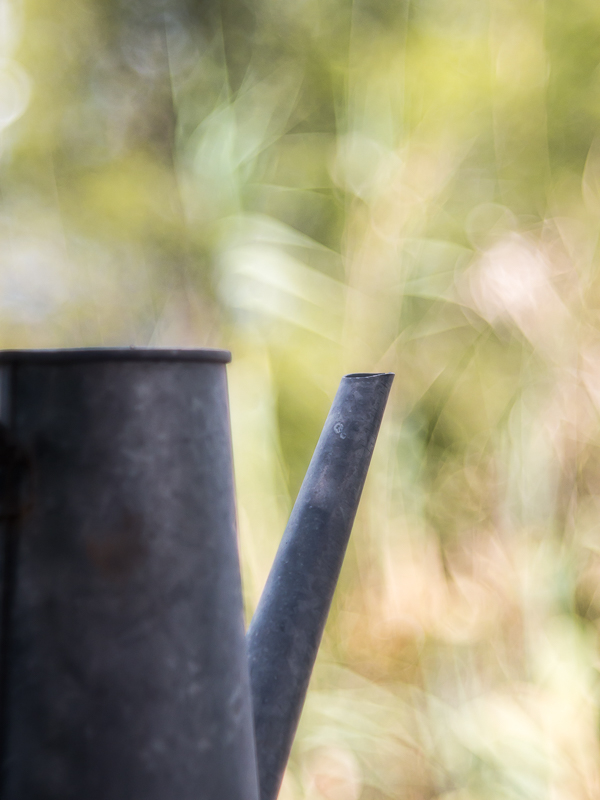

Some kind of iris will have to be implemented, the DOF is too short in most cases.
_________________
Jesito, Moderator 
Jesito's backsack:
Zooms Sigma 70-300, Tamron 35-135 and 70-210 short, 70-210 long, 28-70 CF Macro, 35-70, 35-80, Vivitar 70-210 KA, Tamron 70-250.
Fixed Industar-50, , Tamron 24mm, Tamron 135mm, Sands Hunter 135mm, Pancolar 50mm, Volna-3, many Exakta lenses
DSLR SIGMA SD9 & SD14, EOS 5D, Sony A700 and NEXF3, Oly E-330, E-400, E-450, E-1
TLR/6x6/645 YashicaMat, Petri 6x45, Nettar, Franka Solida, Brilliant
SLR Minolta X300, Fuji STX II, Praktica VLC3, Pentax P30t, EXA500, EXA 1A, Spotmatic(2), Chinon CM-4S, Ricoh, Contax, Konica TC-X , Minolta 5000, 7000i, 3Sxi, EOS 500 and CX
Rangefinders Chinon 35EE, Konica C35 auto, Canonet 28, Yashica Lynx, FED-2, Yashica electro 35, Argus C3 & C4, Regula Cita III, Voigtlander Vitoret (many), Welta Welti-I, Kodak Signette 35, Zorki-4, Bessa-R & L, Minolta Weathermatic, olympus XA2
Compact Film Konica C35V, Voigtlander Vitorets, Canon Prima Super 105, Olympus XA2 and XA3
Compact Digital Olympus C-5050, Aiptek Slim 3000, Canon Powershot A540, Nikon 5200, SIGMA DP1s, Polaroid X530, IXUS55, Kodak 6490, Powershot G9 and G10
CSCCanon EOS-M, Samsung NX100 and NX210, Lumix G5, NEX-F3 |
|
| Back to top |
|
 |
|
|
